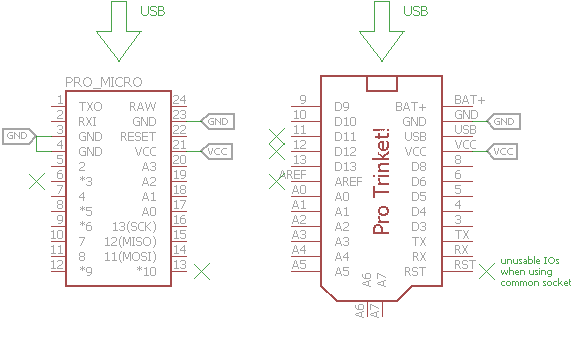In preparation for the next logs I wanted to talk a bit about the pin compatibility between the Pro Trinket and the Pro Micro. The reason why I also want to integrate the Pro Micro is that it's more commonly available and cheaper.

The Eagle parts shown above for both boards pretty much correspond exactly to the actual pinout (besides A6 & A7 on the Trinket and pins 11-13 on the Micro). From these parts we can see that Vcc and one Gnd connection line up such that it would be possible to have a socket fit both boards. Of course, some other pins (e.g. Aref, RST) don't line up which means those pins and the corresponding pins on the other module can't be used and will not be connected on the socket. But there are still enough IO pins that line up with IO pins on the other module for all the in- and outputs of this project.
Using a common socket for both boards means that the software won't work without modification but since they use different implementations of their USB functionality more modifications are required anyway.
For future reference, here's a list of pin correspondencies between the two boards:
| Pro Trinket | Pro Micro |
| 0 | 16 |
| 1 | 14 |
| 3 | 15 |
| 4 | 18/A0 |
| 5 | 19/A1 |
| 6 | 20/A2 |
| 8 | 21/A3 |
| 9 | 1 |
| 10 | 0 |
| 13 | 2 |
| 14/A0 | 4/A6 |
| 15/A1 | 5 |
| 16/A2 | 6/A7 |
| 17/A3 | 7 |
| 18/A4 | 8/A8 |
| 19/A5 | 9/A9 |
 Stefan Lochbrunner
Stefan Lochbrunner
Discussions
Become a Hackaday.io Member
Create an account to leave a comment. Already have an account? Log In.
Brilliantly put, my good man!
Apaet from changing the relative pin numbers the Pro Micro code is essentially an exchange of ProTrinketHidCombo library to the Pro Micro's Keyboard library. Some further lines which are required for the Lro trinket to operate can be removed to have a simpler code.
Once I have done the lin changes you have recommended I shall send you what I have; once you've made it awesome feel free to out it up on your github to accompany the pro trinket code :)
Are you sure? yes | no